The birth of a pencil
A writing tool that looks small, modest, even mediocre, but the impact of a pencil on humans is extremely important.
Margaret Atwood, a Canadian female writer, is ranked among the world's best postmodern writers when she put out 10 writing rules that put pencils on top . 'Write in pencil on the plane. The pen may be worn out but you cannot sharpen the pen because the knife is banned. So prepare two pencils. ' Many celebrities also use pencils for different purposes: Marilyn Monroe used to write emotional love poems, artist Lisa Congdon used pencils to paint beautiful portraits, David Byrne sketched Draft diagram of famous installations.
The modern pencil that appeared in 1795, was an invention of Nicholas-Jacques Conte, a scientist who served in Napoleon Bonaparte's army. The material that constitutes the pencil is pure carbon that we call graphite. This material was first discovered in Europe, particularly in Bavaria, Germany in the early 15th century. Several hundred years earlier, the indigenous Aztecs used graphite as a marking tool.

Nicholas-Jacques Conte, a military service scientist of Napoleon Bonaparte - The inventor of the modern pencil
Initially, pencil material is called by the term plumbago or leads. It was not until 1789 that this material was called graphein, in Greek it meant writing and writing. Particularly, the current noun ' Pencil' comes from the word 'pencillus' , Latin means little tail ("the last little paragraph ," a word that refers to the type of small ink pen used to write in the Middle Ages .
However, the history of pencil also has a rather dark aspect. The largest deposit of graphite was first found at Borrowdale near Keswick in Lake District (England) in 1564. From here, causing smuggling spread in the region. Throughout the XIX century a scale pencil industry was developed around Keswick to exploit high quality graphite.
The first pencil factory founded in 1832 at Keswick and Cumberland Pencil is one of the leading companies producing pencils of the time. The company remains active today even though local graphite deposits have closed and the current supply of graphite is from Sri Lanka and many other remote areas. Cumberland pencils are one of the best quality brands because dust-free graphite and paper "eat" very well. Faber-Castell, which has just celebrated its 250th anniversary, is also one of the world's largest and oldest stationery manufacturers, of which the most famous is the crayon, from children to favorite artists. .

The world's smallest pencil is owned by the world's oldest stationery manufacturer Faber-Castell
The process of producing a pencil begins by heating a mixture of water, clay and graphite in a furnace with a temperature of nearly 1,100 degrees Celsius before wrapping them in a wood cover. The shape of this layer can be square, polygon or circle, depending on the purpose of the pencil, for example, a carpenter never uses a round pencil because they are easy to roll off the desk. . The hardness or softness of the final pencil can only be determined by adjusting the relative fractions of clay and graphite in the calcination mixture. The brand pencil maker advertises that there are 20 types of pencils, from the softest, 9B to the hardest, 9H, in which, H means hard and B means black, and the pencil There are F numbers often used to write more to draw.
The strange thing about graphite is that it is a form of pure carbon that is also one of the softest solids known, and is one of the best lubricants because there are six carbon atoms linked to constitutes adjacent circles.
The oldest recognized pencil in the world, found in a wooden house built in 1630. The reason was a carpenter whose memory was mistakenly forgotten. The pencil is made up of two pieces of wood, inside it is a piece of pure graphite and now belongs to Faber-Castell's storage. The world's most expensive pencil is encrusted with 3 diamonds of 0.05-0.06 carats and the world's smallest pencil is only 17.5mm short and about 3mm thin.
- Perfect design of 99 most expensive pencils on the planet
- Video: The pencil becomes a tree planting tool
- Strange story is unique: Planting with pencil
- Video: 6 tips with pencil sharpeners you may not know
- Uni-ball Kuru Toga - Unscrewed pencil without grinding
- 10 incredible pencil-drawing pictures
- 'Pencil
- Live 55 years with a pencil in the head
- Strange reproduction of pencil fish: The male looks after the eggs hatch
- The 500-year journey rises to the world domination position of a pencil
- Unbelievable artwork on the pencil tip
- Video: Do you understand the symbol No.2?
 'Fine laughs' - Scary and painful torture in ancient times
'Fine laughs' - Scary and painful torture in ancient times The sequence of numbers 142857 of the Egyptian pyramids is known as the strangest number in the world - Why?
The sequence of numbers 142857 of the Egyptian pyramids is known as the strangest number in the world - Why? History of the iron
History of the iron What is alum?
What is alum?